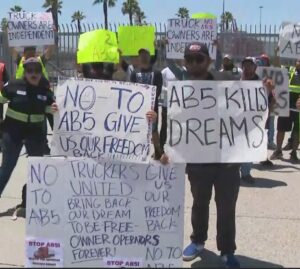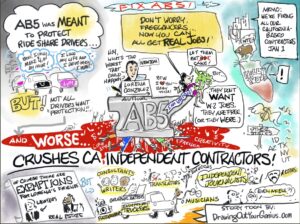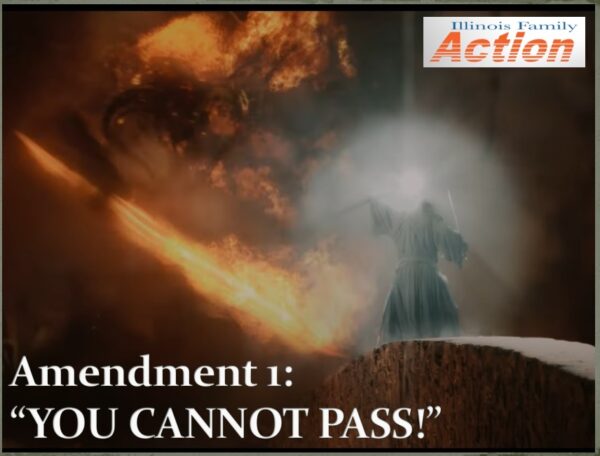
Proponents of Amendment 1 Hidden Agenda: Worker Classification to Grow Union Membership by Robbing Freedom from Workers
Written by John Lopez
No matter how often anyone claims Amendment 1 is not about Worker Classification, the paper trail of proponents proves claims as untrue
This article continues addressing a ballot measure that Illinois voters must vote on this election cycle.
We urge voters to reject Amendment 1, a constitutional amendment that
would elevate collective bargaining rights in the Illinois Constitution,
allowing government union contracts to override state law.
Southern California-based Jennifer Van Laar, managing editor for Red State a Salem Media Group publication, got me hooked on the Cobra Kai series back in 2019. The show, now streamed on Netflix, is a continuation of The Karate Kid movies of the 1980s (the show has yet to include characters from the mid 1990s Next Karate Kid).
Mr. Miyagi is long passed, and Cobra Kai follows the original 1984 movie antagonist Johnny Lawrence (played by William Zabka) and the movies’ protagonist Daniel LaRusso (played by Ralph Macchio) over 30 years after their All-Valley Tournament Championship Finals fight from December 19, 1984.
Cobra Kai is Netflix’s highest rated show, and this fall competes with Amazon Prime’s Lord of the Rings: Rings of Power which drops its episodes Friday.
The Cobra Kai show debuts its 5th season on Friday, September 9, and is set in pre-pandemic Los Angeles (though most of the show is now filmed in suburban Atlanta) in the middle of 2019, and the official trailer dropped in early August reveals Johnny Lawrence is now an app-based/ride-hailing driver. Johnny’s rating shown briefly in the preview.
 The app-based ride-hailing businesses, within Illinois particularly the city of Chicago known as “transportation network providers” (TNP) very relevant to the hidden agenda the proponents of Illinois’ Amendment 1 trying to bring to Illinois.
The app-based ride-hailing businesses, within Illinois particularly the city of Chicago known as “transportation network providers” (TNP) very relevant to the hidden agenda the proponents of Illinois’ Amendment 1 trying to bring to Illinois.
As covered in the previous Illinois Family Action article, proponents have tried to sell Amendment 1, which will top the general election ballot this fall, as a “Workers Rights Amendment” which will apply into the Illinois Constitution a provision that is not needed in the Constitution — preventing Illinois from becoming a right-to-work state.
As thoroughly disussed in the first article, such a protection is not needed, given in the 75 years since the passage of the Taft-Hartley Act of 1947 by the United States Congress, there is no political will to pass right-to-work legislation.
As stated in the previous article:
“The Amendment’s language reads like basic, common sense which should already be in place.
“Applying discernment, common sense shredded and a hidden agenda revealed.”
Today, the hidden agenda will be revealed and while the example of app-based/ride-hailing businesses first highlighted, proponents pushing for passage of Amendment 1 attempting to rob all Illinois workers, in particular 1099 independent contractors, of their freedom to market their labor the way they choose to in the economy of the 2020s, which includes the gig economy or freelancers across multiple professions.
In the previous article, the 2nd bullet supporting a “NO” vote on Amendment 1 will be discussed:
“…proponents present their case focusing heavily on labor unions and not the workers across Illinois or the changing economy for workers choices and entrepreneurships which no longer need representation through a labor union”
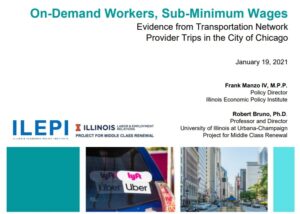 Before deep diving on the events of the summer of 2019 in California, here is what two proponents stated about TNP workers in January of 2021 with emphasis added:
Before deep diving on the events of the summer of 2019 in California, here is what two proponents stated about TNP workers in January of 2021 with emphasis added:
“State lawmakers could classify TNP drivers as employees, granting them full employment rights and access to basic labor protections, including minimum wage laws, overtime pay laws, workers’ compensation coverage, unemployment insurance benefits, and the ability to collectively bargain.”
The Illinois Economic Policy Institute (ILEPI) and the University of Illinois coauthored the 2021 study, which can be accessed here for full context.
The two co-authors, Frank Manzo, IV and Robert Bruno, PhD are two of the coauthors for the proponents’ position paper to support Amendment 1 issued on August 11.
What these gentlemen did not tell their readers was their hidden agenda for Amendment 1, but their paper trail convicts proponents of their plan to take the freedom of Illinoisians through Worker Classification in order to boost union membership.
But state Senator Ram Villivalam (D, Chicago) was quoted a few months later with these revealing words, requoted from The Wall Street Journal editorial published in August 30 print edition:
“The Amendment refers to ‘employees,’ and not workers or individuals…done with intention.”
Proponents of Amendment 1 hidden agenda: transform more Illinois workers into employees through Worker Classification law change.
This has been tried before, and failed miserably in the past 3 years. Amendment 1 must be defeated in order to prevent the same fallout including the loss of choice for workers freedoms from happening in Illinois.
How Amendment 1 Could Be Applied to Force Illinois with a Broader Worker Classification Law — The Story of California’s Assembly Bill 5 (AB5)
As shared in the previous article, last month at the Port of Oakland, independent truckers were joined by rank-and-file union members from the International Longshore and Warehouse Union local against California’s AB5 law.
The saga of AB5, the left’s and union bosses’ attempted use of political muscle to force 1099 independent contractors into W-2 employment and forced unionization started with the landmark California Supreme Court ruling, Dynamex Operations West, Inc. v. Superior Court 4 Cal. 5th 903 in 2018.
The progression which follows begins, what Americans for Tax Reform President Grover Norquist, calls in his op-ed from August 28, 2022:
“…the Democrat war on self-employment, independent contracting and small businesses. The Democrats in California largely banned independent contractors, inculding tens of thousands of independent truck drivers.”
In late 2018 with the start of a new legislative session in the California Legislature in Sacramento, AB5 was authored as the result of the Dynamex decision.
The result, as AB5 snaked its way through approval in both houses of the California Legislature, as New Jobs America founder Mike Hruby shared on August 30:
“…California’s [then] proposed bill ‘AB5’ effectively banning self-employed work for Californians.“AB5 included a severe labor standard called the ABC Test that defined almost all work done by independent contractors as ‘misclassified.’ AB5 thereby subjected every employer using contract work for virtually any reason to harsh penalties and fines.”
The California Legislature passed AB5 on September 11, 2019. Governor Gavin Newsom (D) signed the legislation into law on September 18, 2019, and AB5 law was effective January 1, 2020.
The results of businesses being subjected to penalties and fines was stopping to use independent contractors based from the state of California.
This storyboard by California-based freelancer Lisa Rothstein tells the story, and as she clearly points out, AB5 was not only targeting app-based gig economy drivers:
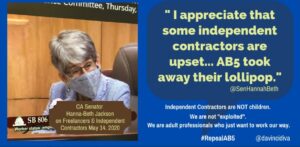 And California lawmakers, after both the onset of the AB5 law and the COVID pandemic, met the negatively impacted independent contractors with scorn and ridicule, including the term “lollipop” by then-state Senator Hannah-Beth Jackson (D, Santa Barbara) in May of 2020.
And California lawmakers, after both the onset of the AB5 law and the COVID pandemic, met the negatively impacted independent contractors with scorn and ridicule, including the term “lollipop” by then-state Senator Hannah-Beth Jackson (D, Santa Barbara) in May of 2020.
As the Rothstein creative meme above illustrates in the lower left corner, the state of California’s AB5 law gave certain industries/professions “carve-outs”, including lawyers, real estate agents, insurance agents and hair dressers.
The initial AB5 carve-outs did not include independent truckers, freelance photographers or writers. Indeed, freelance writers were limited to 35 publications as an independent contractor per year, before being required to stop publishing in a certain publication, or to be made an employee of the publication, which was AB5 proponents objective all along.
The reason W-2 employment crucial to backers of forced unionization is under federal law, W-2 employees can unionize, while independent contractors cannot.
But AB5, and its proponents failed to take into account there are millions of people in California who CHOOSE to be a 1099 independent contractor, and NOT an employee.
The reason was under AB5, and advocated by ILEPI in January of 2021, the use of a worker classification test called the “ABC test” was to be used.
The ABC test, when first implemented in California in 2020 through AB5, harmed over 2 million workers from freelance writers to independent truckers vital to the supply chain challenges facing the nation today was originally developed in the 1930s for factory workers.
The modern ABC test is a three-part test that differentiates W-2 employees from 1099 independent contractors for tax status. Under a law with the ABC test for tax status, a worker is automatically considered an employee for unless they meet all three of the following criteria.
- The worker is free from the control and direction of the hiring entity in connection with the performance of the work, both under the contract for the performance of the work and in fact;
- The worker performs work that is outside the usual course of the hiring entity’s business; and
- The worker is customarily engaged in an independently established trade, occupation, or business of the same nature as that involved in the work performed.
B is where most 1099 workers run into trouble. This is where the left tries to force employers to reclassify their workers from 1099 independent contractors to W-2 employees, who would then likely be forced into union membership.
The left’s government-knows-better mentality wants all workers to be forced into a union and pay union dues so that unions will fund leftist politicians and their causes, including Planned Parenthood.
In the recent Florida primary, media reports revealed Congressman Charlie Crist’s (D) campaign for governor was supported with $500K by the American Federation of Teachers two weeks before the August 23 Democratic primary, without input from the rank-and-file, some of whom were backing Crist’s primary opponent, Agriculture Commissioner Nikki Fried (D).
The ABC test is currently used for tax status in two states: Massachusetts and California.
Illinois uses the ABC test for workers and unemployment compensation, but NOT for tax status with the exception of the construction industry. The “common law,” or “IRS test,” is used for tax status in Illinois which favors workers determining for themselves how to be classified.
The testimonies of independent contractors negatively impacted by AB5 are heartbreaking, and some of them could be read here.
One personal testimony stands out for me, and that is Ildikó Santana, delivered in June of 2022:
“I have been a freelance translator and interpreter in California as a self-employed independent contractor by choice for over 20 years, a member of the American Translators Association. I set my rates and my work hours. It too me 20 years to build up my clientele, and one signature to lose it all on January 1, 2020, by…AB5 – authored by the AFL-CIO…signed by Governor Gavin Newsom on September 18, 2019.
“The effects of AB5 were devastating on the language industry, on millions of people who were left without language services, and on me personally. None of my 50 agency clients would hire me as an employee, and I could no longer service my clients as an independent contractor unless I left California…
“The financial burdens caused by AB5 were tremendous. Our livelihoods were destroyed overnight by AB5, under which select professions were exempt and thus protected, arbitrarily discriminating against the majority of the more than 600 professions that were harmed by this desctructive piece of legislation.
“AB5 must be repealed, and AB5 harms must not be repeated…
“We must protect our rights to earn a living, contribute to the U.S. economy, and recover from the pandemic.”
“Why don’t you actually try to tell us what, in the actual amendment, would cause forced unionization?”
The above question was asked by a Democratic political consultant and it’s a fair question. Let’s re-read the wording of Amendment 1, with emphasis added:
“Employees shall have the fundamental right to organize and to bargain collectively through representatives of their own choosing for the purpose of negotiating wages, hours, and working conditions, and to protect their economic welfare and safety at work.
“No law shall be passed that interferes with, negates, or diminishes the right of employees to organize and bargain collectively over their wages, hours, and other terms and conditions of employment and work place safety, including any law or ordinance that prohibits the execution or application of agreements between employers and labor organizations that represent employees requiring membership in an organization as a condition of employment.”
Once a constitutional amendment is passed, all laws already on the books must be “constitutional” to the amended constitution. The legal principle of a constitutional amendment superseding existing laws, and interpretation of such laws, would be in play with the passage of Amendment 1.
Remembering how the Dynamax decision in the California Supreme Court was rendered, and the emphasized language above, Illinois’ current Employee Classification Law (820 ILCS 185 /), which only applies to the construction industry, could be challenged under the amended Constitution with Amendment 1 applied.
The fact 1099 independent contractors outside of the construction industry (as defined in the statute) cannot unionize due to their worker classification could be interpreted as, “…interferes with, negates, or diminishes the right of employees to organize…”
Then an Illinois Court could easily rule all Worker Classification laws for tax status in Illinois complies with Amendment 1 for the benefit of organizing and collective bargaining.
Then the ABC test becomes Illinois law, current 1099 independent contractors are classified as employees, and if they are hired as employees, will be forced to join a union, or be forced to find empoyment elsewhere.
Sounds pretty straight forward to this 1099 independent contractor from Algonquin, IL.
The current statute for the construction industry combines the ABC test with the Common Law Test.
Could an Illinois judge compel Illinois lawmakers to simplify the tests for worker classification with Amendment 1 in place? Definitely, yes.
It happened in California, and what’s the old saying, “As California goes, so does…”
Returning to the ILEPI January, 2021 recommendation, with emphasis added:
“…state lawmakers could treat TNP [transportation network providers] drivers who provide labor or services for remuneration as employees. Under this potential option, TNP workers would be classified as employees unless the TNP companies can prove that the workers are free to perform services without the control or direction of the companies, the workers perform tasks that are outside the usual course of the companies’ activities, and the workers are engaged in an independent occupation or trade of the same nature.”
Where has the emphasized language ILEPI published as a recommendation over a year and a half ago been seen before? Yes, it’s the ABC test.
No matter how often anyone claims Amendment 1 is not about Worker Classification, the paper trail of proponents like ILEPI will dismiss such claims as untrue.
The next article will deal with legislation and actions in Washington, D.C. to prove how proponents of Amendment 1 are working with others to pass the federal version of California’s AB5 law, and how AB5 language was copied and pasted into the Protecting the Right to Organize (PRO) Act in late 2019.
Finally, some more testimonies from independent truckers protesting AB5 in the short video can be viewed here and here and note how union leaders respond to the independent truckers’ dilemna. Just like the “lollipop” comment shown above, that condescending attitude permeates from Amendment 1 proponents, from Governor JB Pritzker on down.
Sadly, earlier this week, a Federal judge lifted the restraining order preventing the enforcement of AB5 against independent truckers, which was expected after the United States Supreme Court declined to hear the case on June 30.
May the truth set all Illinoisans free to Vote NO on Amendment 1.
Note from John Lopez: The Illinois Economic Policy Institute tweeted a reply to me labeling my linkage of Amendment 1 to Worker Classification as “Misinformation”. After support from friends and fellow freelancers, the ILEPI deleted their tweet, but enough people saw it, and moving forward, I will be screen capturing all hostile tweets on this topic.
Feature photo credit The Bridge of Khazad-dûm, Lord of the Rings: The Fellowship of the Ring produced by New Line Cinema, co-produced by Wingnut Films, 2001, with additions by John Lopez, Policy Political Consulting
John Lopez has written about policy and elections through the McHenry County Blog since 2019 through July 2021. He is now semi-retired, and does freelance work with analytics, as well as political candidates, emphasizing policy as the means to advance the conservative message, by engaging through policy “dog fighting”, applying discernment for winning and advancing God’s Kingdom agenda.
John’s known for getting past the talking points, the narratives, the abstracts, the platitudes and the bromides in order to discuss policy and apply Scripture to overcome unholy divisions in the local community, our state, and nation. John has been married for over 17 years.
Follow John on Twitter: @MarcVAvelar


